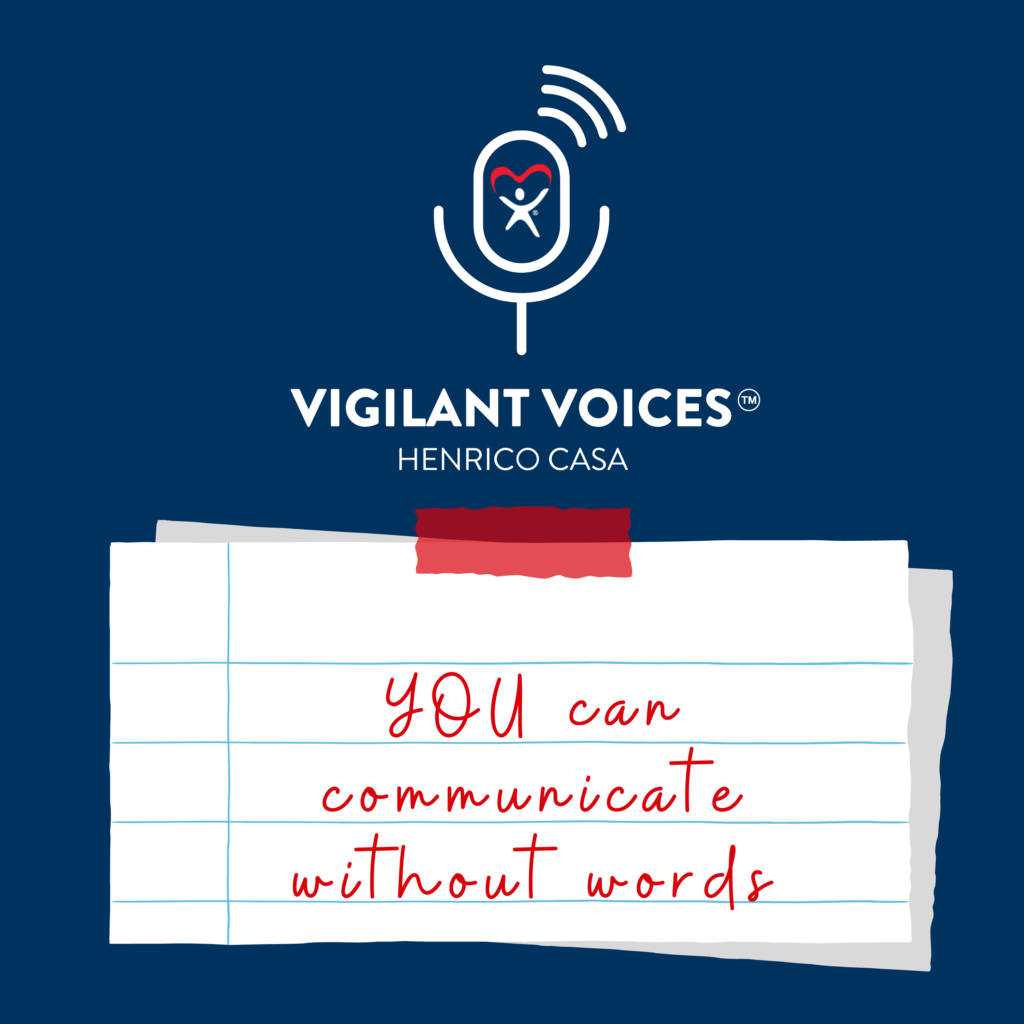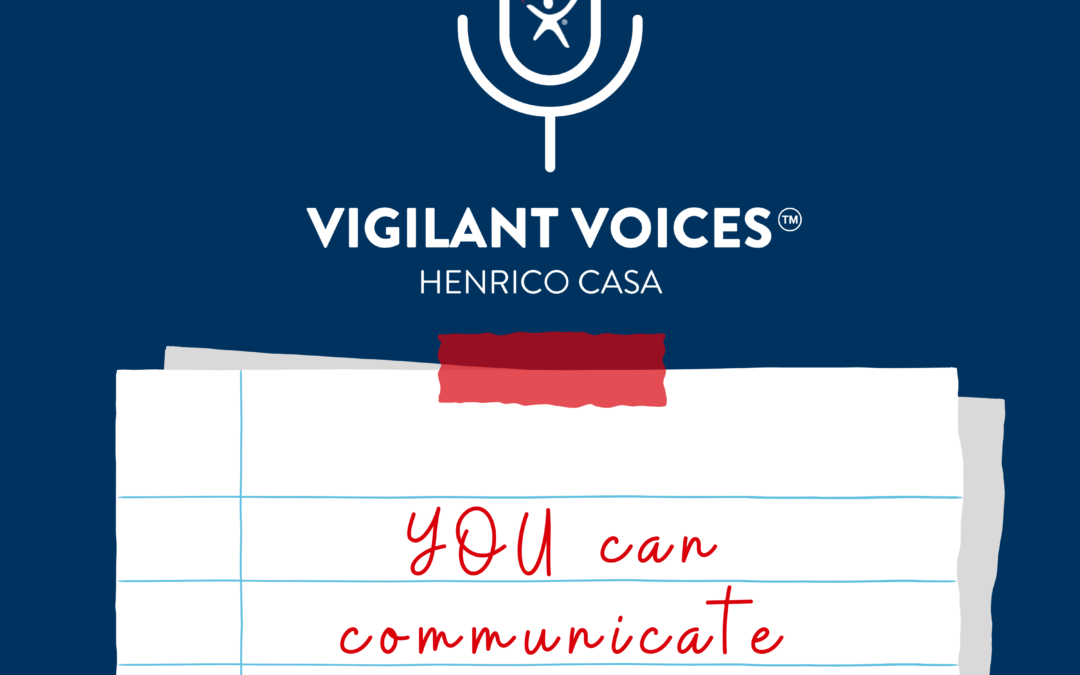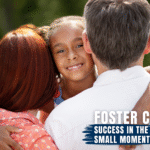
Listen to Episode 8 of the Vigilant Voices™ podcast, YOU Can Communication Without Words.
Jeannine Panzera: Hello, listeners. We’re glad to have you listening. We love connecting with people like you who care about the well being of children.
Kristin Blalock: Yes, we most definitely do. The more of us who know about the challenges facing children and families, the more of us who will be making a difference in the community to ensure that no child continues to face abuse, neglect, or trauma. And that’s why we’re doing this Vigilant Voices™ podcast.
J: That’s exactly why we’re doing this. And part of knowing about challenges facing children and families is first, understanding the basics of ages and stages of child development. We talked about these stages at that really high level in our last episode, and we will be diving a little deeper today into how our younger children communicate when they may be too young for words.
K: So, listener, I guess if you haven’t heard our last episode, you might want to pause here, go back and listen to episode seven and then rejoin us here for episode eight.
J: Yes. Go ahead and pause. We will be waiting right for you right here.
K: Perfect. Okay, so before we dive in, I wanted to share a classic case story to get us started like we usually do. This is Baby Jane’s story. And again, we always change names for privacy. But baby Jane was just recently appointed a CASA, which again stands for Court appointed Special Advocate. She was appointed a CASA volunteer by a judge in the Juvenile and Domestic Relations Court, and it’s suspected that Baby Jane’s birth parents physically abused her. She’s actually now facing long term disabilities resulting from harm to her, I hate to even say this, her sweet little head. She’s safe now. She’s residing with another relative. And her CASA volunteer is starting to help professionals gather information about maybe other options for long term caregivers for her.
J: The cases that involve infants are really difficult because they’re completely vulnerable. They’re just at the mercy of adults caring for them, or in this case, not, which resulted in harm. And so I hate that this sweet little girl has experienced this. But I think it’s also important for us to share stories because unfortunately, the reality is that infants and toddlers are disproportionately at risk for maltreatment due to their age.
K: They are. And unfortunately, Baby Jane isn’t the first and won’t be the last case that we see like this. I know I’ve noticed that physical abuse to a baby sometimes happens because parents become overwhelmed and frustrated with an infant’s inability to communicate needs, or when that baby maybe can’t be consoled like a very colicky baby who is up 24 hours. And if you don’t have good support system, it can be very overwhelming.
J: And so oftentimes when we’re working on a case, really no matter what age of the child, but certainly for our younger children, we are working to help connect parents with services like parent coaching or respite care, because we recognize that caring for a baby can be exhausting. And so having someone who is encouraging, who can provide a break, be that support can just make a huge difference and prevent abuse.
K: Yeah. And that leads us directly to what we wanted to chat about today, which is communicating with children. Specifically, how can we communicate with the little ones who are just too young for words?
J: Right. So as Court Appointed Special Advocates, or CASA, we’re serving as a voice for children in the court system and child welfare systems .For our older children and youth that we serve, we’re amplifying their voices because they have a voice, they can speak words. And so we’re amplifying that to make sure that those wants and needs and best interests for them are not lost in the system or potentially overlooked by sometimes louder adult voices. But for our little ones, sometimes it’s even more important to serve as their voice because they don’t really have one.
K: Well they do, they just don’t have words. Like cooing, fussing, crying and we have to make sense of that. Right, but they also communicate in so many nonverbal ways. So we need to remember that every single interaction we have with them, like every little snuggle or whatever it is, it’s a form of communication.
J: Absolutely. And so, as we all should know, communication goes way beyond just our words. So we know that verbal communication is certainly what we say, but it does go a little bit deeper because it’s about the pitch and even the tone of our voice. And little ones can pick upon our moods, our intentions. And so if you make a certain little sound before, let’s say you change their diaper, they know what’s coming. They start to learn that. And then in addition to our verbal sounds and words, there’s the very important nonverbal communication.
K: Which actually makes that 90% of what we communicate.
J: I didn’t realize it was that high, but I believe it. And that nonverbal communication really is oftentimes intentional. It’s making eye contact or not giving a hug, using hand gestures or maybe unintentional facial expressions that you can’t hide. Or maybe just how you just instinctively move away if you feel that someone is invading your personal space. Those are nonverbal communications but something has occurred that you still feel something, you notice something. And it can flash across your face so quickly and the kids notice.
K: Right .And when we communicate, whether it be verbal or nonverbal, we’re modeling communication skills for our children. So when they see other people, they’re likely going to communicate in a way similar to how you have communicated with them or in front of them. Which side note is why it’s so embarrassing when they say something bad or negative because you know everyone’s thinking they heard it from you at home first. But seriously, it’s interesting to note that it does impact how they build relationships later in life.
J: I mean, it’s shaping their emotional development. So communicating with kids in a way that allows them to process and respond in a healthy manner is a very important step in development. I have always been concerned about how child development is being, in my opinion, impacted by all the screen time and cell phone. Because we’re using them all the time. Our time then on our phones, our computers or televisions, really can interrupt development if we’re not spending more time and purposeful time, like making eye contact with a baby or a young child or not modeling true back and forth conversation. And so little ones really don’t need to be plopped in front of the television. So they’re quiet. They need focused verbal and nonverbal interactions with us.
K: Yeah, they do. And I mean, it is so easy to not give them as much of it as they need when we’re distracted. I mean, eye contact is such a big part of connecting with these little ones. And our eyes can be diverted to our phones and devices and just other distractions. And that affects their connection and attachment with us .And it could be affecting their ability to communicate with us or to learn how to communicate from us.
J: Exactly. And so what we wanted to talk a little bit about in today’s episode are some intentional communication games or activities that we can incorporate into interactions with newborns babies, young children. And so if you find that verbal and nonverbal communication isn’t naturally happening potentially as much as you’d like in your daily routine, here’s some ideas that you could incorporate into your time.
K: Yeah, and I’m really glad we’re doing this because when you value something, and I can assume that we all value our children, it’s really important to take deliberate steps to prioritize it. So let’s all be intentional about communicating well with our kids.
J: Exactly. Make it a priority. So the first activity that we always suggest is really pretty simple and it’s called Serve and Return. We’ve mentioned this before. It, like I said, is simple. And while simple, sometimes it’s easy to gloss over what this actually means and those interactions and how important it is. Because if we do so, we’re actually skipping over very important developmental learning and brain development for our little ones.
K: Yeah. And I’m going to add a link to the Center on the Developing Child at Harvard to our show notes because I really love how they specifically break down this Serve and Return concept.
J: Thank you for doing that. It’s a fantastic resource. And so when we think of serve and return, it is very simply communication back and forth. Serve and return. Think of a tennis ball going back and forth right on the court. It starts with simply paying attention. And so the first step is really noticing when a child, quote unquote, serves to you. So they might be smiling, they might be cooing, they might be pointing. You know, they’re sending a message your way in their own type of communication at their own stage. And so then your job as a parent/caregiver/friend whomever you might be in that child’s life is to return that serve. Respond. When they smile, smile back. When they coo, say, “oh, I hear you talking to me.” That’s why we use the baby talk. But it’s actually very important because that is part of that serve and return of a child and a parent or caregiver responding back and forth with some type of sound.
K: And if possible, your return, can name something so like person, place, thing, feeling. Like if a little one is pointing at a bird, and that’s their serve to you, your return could be, “oh, do you see that little bluebird? I see it too.” If they’re fussing, your return could be, “oh, someone’s hungry! I get mad when I’m hungry, too.” But the act of naming things creates language connections in their brain. And so even for children who aren’t yet talking or using words, those connections are really important.
J: Their brains are like sponges. They really are taking in everything. And that’s the simplicity of that serve and return. It really is a back and forth communication. But you have to do it right. So the act of accepting and then responding to a baby or child’s cues is very important. There are really interesting videos and studies where parents are told to not return a child’s serve. The reaction is fascinating. Very quickly they start to get confused, they’re upset, they’re looking around, they then begin to cry or are inconsolable because their parent is in the room, but is completely unengaged and non responsive to them.
K: Oh, I’ve seen these too. And it’s fascinating because as soon as the parent starts reengaging, even with like a simple look back towards the child ,that baby or child is immediately consoled. So, yeah, that’s so interesting. And one other thing I’d say about the Serve and Return is it’s a great example of how children learn through play. I mean, it’s just a playful back and forth, but it’s vital building blocks for development.
J: Play is important, which is good news because it’s fun. And the other thing about the Serve in Return is that it can also be used with children who are nonverbal, which is fantastic, and we love that. And so that’s another way, though, that they’re still able to communicate, maybe just not with spoken words. And so as we’re coming toward the end of our episode here, maybe, Kristin, we can give a few ideas of ways to practice communication with young children who are verbal.
K: I think that’s a great idea. For young children who are verbal, I know I’ve always liked to use what I call ‘noticing statements.’ It’s kind of a way of being more specific. When you’re communicating with a child, again, you’re building their vocabulary. For example, instead of saying, “good job cleaning up,” maybe you say something like, “I noticed that you put your shoes away right where they belong. Thank you.” It’s such a minor difference, but it clearly points out what you’re trying to draw the child’s attention to and just really conveys like, I see you, I value you.
J: Well, and I think it’s great for teaching or reinforcing the behavior that you’re hoping for. You’re acknowledging that they did exactly what you’ve been asking for, and so you’re saying, I see you.
K: Yeah. And it’s also great for helping children grow their emotional intelligence because there are so many types and ranges of emotions. In the beginning, they maybe know mad and sad or just a couple. So saying things like, “I noticed that you did whatever, is that because you’re sad or mad?” We could help them learn to put words with their emotions, and then the more their emotional vocabulary grows, the more they’ll be able to communicate those thoughts, feelings, and needs with us.
J: Right. And the other awesome thing about that is when it’s the concept of noticing that means that you’re connected and you’re noticing your child, it’s very important. And so the other communication skill that I like to practice with children and adults, too, is active listening, and then what we call reflective listening. So hopefully we all understand what active listening means. It’s making sure that a child feels heard and understood. And sometimes that means that we, as the adult, have to do very little talking or solving. We might be smiling, we might be nodding, we might be asking some questions to get a little bit deeper, but we’re just listening to them, which is important.
K: Very much so. Yeah.
J: And then there’s reflective listening. And this is another really good way to show that we’re noticing, we’re paying attention, and that’s really where we actually just mirror back to them what they said. So I love carrots. .And so if they say, “these carrots are yummy,” instead of me saying, “I like them too,” I might say, “oh, you like the carrots.” And it’s a very different way, but very simple way of showing them that, again, you’re paying attention and you’re noticing and you’re commenting directly to them.
K: It’s just such a simple way of showing that you care, and that what the child is saying is valuable. You’re not thinking of your response. You’re just valuing what they have said to you.
J: Exactly. And what every child thinks and feels is important. And that’s why our team at CASA takes our role as child advocates so seriously. Because sometimes we are stepping in to be these advocates when parents or caregivers are unable to do so.
K: I’m so glad that one of our CASA volunteers is actively advocating for Baby Jane, because she definitely isn’t old enough to communicate with words. Thankfully, she’s safe now, but her future is unknown. She has an adult looking out for her best interests, which is fantastic, thanks to our volunteer. And we’re helping determine where she will be safe and who can provide security to her long term. But having an advocate will prevent her from future abuse or from instability that comes from bouncing around between other caregivers more than what’s necessary.
J: And we’re so thankful that her CASA volunteer visits her weekly, is able to then communicate her care through the volunteers words and reporting that back to the professionals and the court system. But then she’s also able to interact and communicate with Jane. She’s a very warm, lovely volunteer. But she’s engaging, too, though, in nonverbal communication by showing up and interacting with that child.
K: So that’s, again, a really simple call to action that we can make our challenge for the day. We just challenge everyone, all of us, to choose a child in our life and communicate how much love and how much you value them in a nonverbal way. So that’s the challenge. Don’t use words. Convey to a child how much you value them without words.
J: That’s a good challenge. And so we would love to hear about how it goes. So we want to hear about those smiles, hugs, secret handshakes, et cetera, that are taking place out there .Let us know. Reach out to us. We’d love to hear some things that worked for you that we could potentially share in our notes. And so, through this, we’re hoping that the children in our community feel loved and valued through our interactions with them, both verbal and nonverbal.








